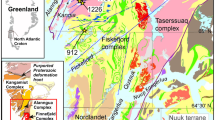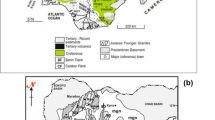Abstract
THE Scourie dyke swarm intrudes the Lewisian Complex in north-west Scotland. The structural state of these basic dykes is used to subdivide the Lewisian into the pre-dyke ‘Scourian’ and post-dyke ‘Laxfordian’ complexes1. The ∼2,700 Myr (refs 2–4) pyroxene-granulite facies Scourian gneisses of the Assynt area contain undeformed NW-trending dykes. Gneisses and dykes, which underwent the ∼1,900 Myr (refs 5, 6) Laxfordian event, are now deformed and metamorphosed at amphibolite facies. Previous K–Ar measurements for the Scourie dykes in the Assynt area of the Lewisian gave a minimum age for dyke injection of 2,200 Myr (ref. 7). Younger K–Ar ages were thought to reflect later Laxfordian overprinting. I report here a Rb–Sr whole-rock isochron age of 2,390±20 Myr (2σ) and an initial 87Sr/86Sr ratio of 0.7022±0.0001 (2σ) for the Scourie dykes.
This is a preview of subscription content, access via your institution
Access options
Subscribe to this journal
Receive 51 print issues and online access
$199.00 per year
only $3.90 per issue
Buy this article
- Purchase on Springer Link
- Instant access to full article PDF
Prices may be subject to local taxes which are calculated during checkout
Similar content being viewed by others
References
Sutton, J. & Watson, J. Q. Jl geol. Soc. Lond. 106, 241–307 (1951).
Chapman, H. J. & Moorbath, S. Nature 268, 41–42 (1977).
Moorbath, S., Welke, H. & Gale, N. H. Earth planet. Sci. Lett. 6, 245–256 (1969).
Pidgeon, R. T. & Bowes, D. R. Geol. Mag. 109, 247–258 (1972).
Lambert, R. St. J. & Holland, J. G. J. geol. Soc. Lond. 128, 3–19 (1972).
Chapman, H. J. thesis, Oxford Univ. (1978).
Evans, C. R. & Tarney, J. Nature 204, 638–641 (1964).
O'Hara, M. J. Mineralog. Mag. 32, 848–865 (1961).
Faure, G. & Powell, J. L. Strontium Isotope Geology (Springer, Berlin, 1972).
Evans, C. R. & Lambert, R. St. J. J. geol. Soc. Lond. 130, 125–150 (1974).
Tarney, J. Nature 199, 672–674 (1963).
Tarney, J. in Early Precambrian of Scotland and Related Rocks of Greenland (eds Park, R. G. & Tarney, J.) 105–118 (1973).
Evans, C. R. Nature 207, 54–56 (1965).
Moorbath, S. & Park, R. G. Scott. J. Geol. 8, 51–74 (1971).
Watson, J. in Geology of Scotland (ed. Craig, G. Y.) 49–77 (1965).
Watson, J. Geol. Soc. Lond. Spec. Rep. no. 6, 15–29 (1975).
Pankhurst, R. J. & O'Nions, R. K. Chem. Geol. 12, 127–136 (1973).
O'Nions, R. K. & Pankhurst, R. J. Earth planet. Sci. Lett. 21, 13–21 (1973).
Steiger, R. H. & Jäger, E. Earth planet. Sci. Lett. 36, 359–362 (1977).
Author information
Authors and Affiliations
Rights and permissions
About this article
Cite this article
CHAPMAN, H. 2,390 Myr Rb–Sr whole-rock for the Scourie dykes of north-west Scotland. Nature 277, 642–643 (1979). https://doi.org/10.1038/277642a0
Received:
Accepted:
Published:
Issue Date:
DOI: https://doi.org/10.1038/277642a0
This article is cited by
-
Archaean crustal development in the Lewisian complex of northwest Scotland
Nature (1994)
-
Polymetamorphic evolution of the Lewisian complex, NW Scotland, as recorded by U-Pb isotopic compositions of zircon, titanite and rutile
Contributions to Mineralogy and Petrology (1994)
-
U–Pb baddeleyite ages for the Scourie dyke swarm, Scotland: evidence for two distinct intrusion events
Nature (1989)
-
Age and origin of early Proterozoic dolerite dykes in South-West Greenland
Contributions to Mineralogy and Petrology (1985)
-
A Sm-Nd isotopic study of the South Harris Igneous Complex, the Outer Hebrides
Contributions to Mineralogy and Petrology (1983)
Comments
By submitting a comment you agree to abide by our Terms and Community Guidelines. If you find something abusive or that does not comply with our terms or guidelines please flag it as inappropriate.



